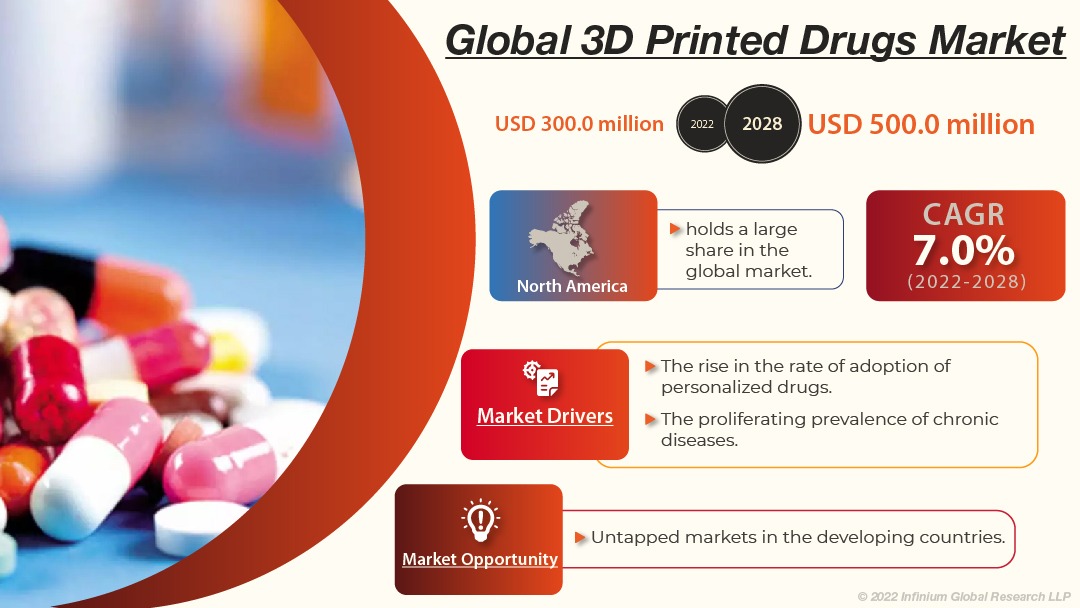3D Printed Drugs Market (Technology - Inkjet Printing, Fused Deposition Modelling (FDM), Stereolithography (SLA), and Others; Application - Orthopedic, Hearing & Audibility Aid, Medical Implants, Dental, Neurology, and Others): Global Industry Analysis, Trends, Size, Share and Forecasts to 2028
A recent report published by
Infinium Global Research on 3D printed drugs market provides in-depth analysis
of segments and sub-segments in the global as well as regional 3D printed drugs
market. The study also highlights the impact of drivers, restraints, and macro
indicators on the global and regional 3D printed drugs market over the short
term as well as the long term. The report is a comprehensive presentation of
trends, forecast and dollar values of the global 3D printed drugs market. According
to the report, the global 3D printed drugs market is projected to grow at a
CAGR of over 7% over the forecast period of 2022-2028.
Market Insight
The 3D printed drugs market was valued
at over USD 300 million in 2022 and is expected to reach about USD 500 million in 2028,
with a CAGR of over 7% during the forecast period. 3D printing has become one
of the most pioneering technologies in the pharmaceutical field. There has been
a significant development in the manufacture of drug delivery and medical
devices within the last decade. 3D printing facilitates the potential for printing
dosage forms on-demand, with low cost and ease of use. The industry is leading
towards personalized medicine because the dosing and release characteristics of
the drug delivery devices can be easily changed. It can be done by altering the
geometries of the 3D design using computer-aided design (CAD). The approval by
FDA for the 3D-printed drugs has fuelled interest in 3D printing technology in
the pharmaceutical industry.

The rise in the rate of adoption
of personalized drugs is the key driving factor for the 3D printed drugs
market. The need for personalized dosing arises from differentiation in the
patient’s age, weight, and severity of the disease. The personalized drugs are
suited for the patient’s individual needs thus minimizing the potential for
adverse effects of the drug. Individualized medications fabricated through 3D
printed offer an important benefit to patients. Printable dosage forms on paper
are easier to deliver to the patient than powder-based printed forms.
Furthermore, the proliferating prevalence of chronic diseases is also driving
the global 3D printed drugs market. The investments in research and development
of 3D printed drugs and innovation in the manufacturing of biologics are
anticipated to yield more products during the forecast period. The investments
in research and development of 3D printed drugs and innovation are anticipated
to yield more products during the forecast period.
With the outbreak of the COVID-19
pandemic, urgent needs for medical and specialized products have been
overwhelming especially personal protective equipment. The conventional
production line of medical devices has been challenged by excessive global
demand during the pandemic. The need for an easy, low-cost, and rapid
fabrication method is felt more than ever in recent times. The manufacturers
referred to 3D printing to fill the gap in a scramble to address this shortfall
and boost the production line of medical devices.
Geographically, North America
holds a large share of the global 3D printed drugs market owing to the
increasing number of chronic disorders, and the presence of advanced domestic
healthcare infrastructure in this region. The factors such as high investment
in research and development, and rising adoption of technological advancements
in 3D printing are also driving the North America 3D printed drugs market. The
presence of a large geriatric population in countries such as Germany and The
United Kingdom drives the growth of the European 3D printed drugs market.
Segment Covered
The report on the global 3D printed
drugs market covers segments such as technology, and application. On the basis
of technology, the sub-markets include inkjet printing, fused deposition
modelling (FDM), stereolithography (SLA), and others. On the basis of
application, the sub-markets include orthopedic, hearing & audibility aid, medical implants, dental, neurology, and others.
Companies Profiled:
The report provides profiles of
the companies in the market such as GlaxoSmithKline plc. Hewlett Packard
Caribe, Aprecia Pharmaceuticals, 3D Printer Drug Machine, Merck KGaA, Triastek,
Inc., FabRx Ltd., Cycle Pharmaceuticals, GE Healthcare, and Other Companies.
Report Highlights:
The report provides deep insights
into demand forecasts, market trends, and micro and macro indicators. In
addition, this report provides insights into the factors that are driving and
restraining the growth in this market. Moreover, The IGR-Growth Matrix analysis
given in the report brings insight into the investment areas that existing
or new market players can consider. The report provides insights into the
market using analytical tools such as Porter's five forces analysis and DRO
analysis of the 3D printed drugs market. Moreover, the study highlights current
market trends and provides forecast from 2022-2028. We also have highlighted
future trends in the market that will affect the demand during the forecast
period. Moreover, the competitive analysis given in each regional market brings insight into the market share of the leading players.
